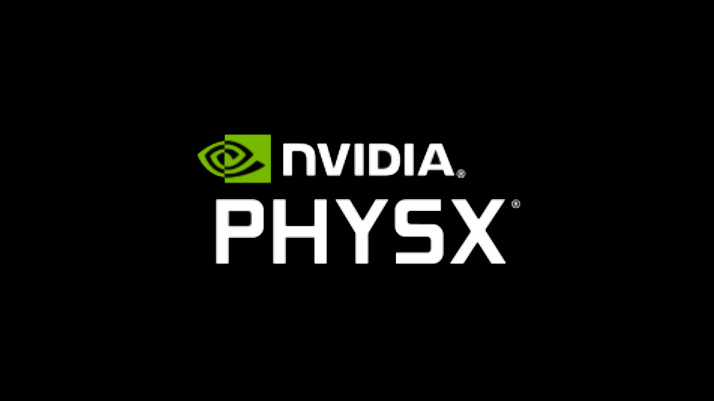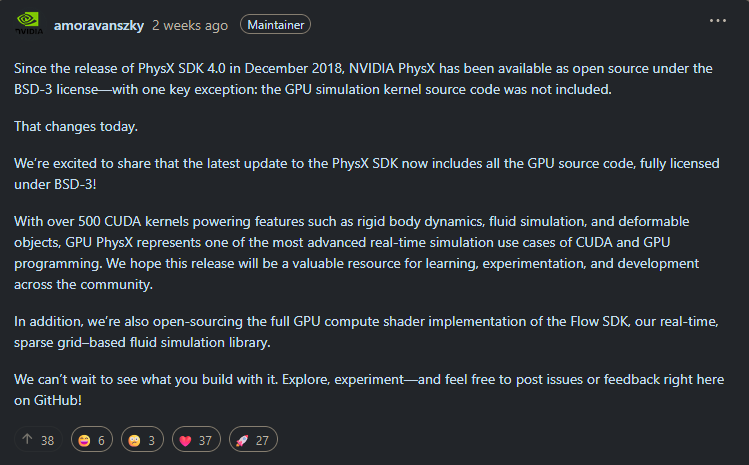Nvidia's PhysX and Flow go open source — Running legacy PhysX on RTX 50 may be possible using wrappers
With enough effort, it might also be possible to port PhysX and Flow for Intel/AMD hardware.

Nvidia's PhysX and Flow SDKs are now completely open-source under the permissive BSD-3 license. If you've been a part of the developer community, these libraries have been open-source since late 2018, except for the key GPU simulation kernels. Releasing the source code for these kernels paves the way for game developers to integrate custom and highly optimized variations of PhysX and Flow, while the modding community might see this as an opportunity to run legacy PhysX code on unsupported RTX 50 GPUs through compatibility layers.
PhysX is a real-time physics engine that offloads complex calculations to your GPU, capitalizing on its parallel processing, and powered under the hood by CUDA. This technology has been employed in a handful of older titles from the 2010s, some notable examples of which are Mirror’s Edge, Batman: Arkham Asylum, Metro 2033, Borderlands 2, and the list goes on.
The fact that most of these games relied on a 32-bit PhysX implementation, combined with Nvidia's decision to discontinue 32-bit CUDA on their Blackwell GPUs, causes the intricate physics simulations that are designed and optimized for parallel computing to fall back to the CPU, crippling performance. Flow is more specialized and serves to power fluid simulation mechanics. Think of fire, gas, and smoke effects.
With PhysX 4.0, Nvidia made public the CPU-side simulation source code of PhysX, but the GPU-side kernels were still proprietary. Limited to the binaries only, understanding the system's internals and customizing it for specific needs was almost impossible. However, with Nvidia's special GPU acceleration sauce now out in the open, anyone can see, study, modify, and build on these existing libraries.

We won't be surprised if modders now work to create a 32-bit to 64-bit compatibility layer to enable PhysX support for older titles on Blackwell GPUs. With access to the source code, it's technically possible to decouple PhysX and Flow from CUDA and port the technology to hardware-agnostic platforms like OpenCL/Vulkan to enable support for AMD and Intel processors, but that's much easier said than done.
For the most part, PhysX is a dead technology for games and has been superseded by alternatives; for example, Unreal Engine 5 uses the new Chaos Physics engine. However, access to the PhysX's GPU kernels and the shader simulation code for Flow is likely to have far-reaching impact for graphics engineering, robotics, architecture and design, animation, and the list goes on.
Get Tom's Hardware's best news and in-depth reviews, straight to your inbox.

Hassam Nasir is a die-hard hardware enthusiast with years of experience as a tech editor and writer, focusing on detailed CPU comparisons and general hardware news. When he’s not working, you’ll find him bending tubes for his ever-evolving custom water-loop gaming rig or benchmarking the latest CPUs and GPUs just for fun.
-
ezst036 This is very welcome news, thank you Nvidia.Reply
The way companies conduct themselves these days so often you primarily find that the only proper response is to complain. -
beyondlogic If it's possible I don't understand why Nvidia didn't put the work in to make it workReply -
mac_angel Reply
yea. It was a great technology right from the beginning, along with the other 'daughter' technologies that came out of it (HairWorks, Turf Effects, and others). They also had a great audio one that was able to render audio to sound like it should in different environments (Hall, small room, open space. Stone, wood, etc). These would have been really awesome if they didn't try to make everything proprietary and it then gets left in the dust by game developers.beyondlogic said:If it's possible I don't understand why Nvidia didn't put the work in to make it work
I think games could, should have come a lot further graphics wise if NVidia had have gotten on board with Vulkan. Jensen Huang has seriously lost his morals from when he started NVidia. He used to constantly say he wanted to make gaming graphics for everyone; wanting to support the wants and needs of the customers. Now everything is about $$$ and <Mod Edit> over as many as he can to accomplish it. The problem with the power and the 4090s was pretty bad, but it's relatively minor to what's going on with the 50 series (power, as well as missing ROPS - seriously, how do you release a product with missing ROPS and not know about it). -
stonecarver Reply
I agree the Soundstorm Audio chip that was part of the nForce2 chip was awesome. Asus A7N8x motherboard had it back in the day.mac_angel said:They also had a great audio one that was able to render audio to sound like it should in different environments (Hall, small room, open space. Stone, wood, etc). These would have been really awesome if they didn't try to make everything proprietary and it then gets left in the dust by game developers. -
beyondlogic Replymac_angel said:yea. It was a great technology right from the beginning, along with the other 'daughter' technologies that came out of it (HairWorks, Turf Effects, and others). They also had a great audio one that was able to render audio to sound like it should in different environments (Hall, small room, open space. Stone, wood, etc). These would have been really awesome if they didn't try to make everything proprietary and it then gets left in the dust by game developers.
I think games could, should have come a lot further graphics wise if NVidia had have gotten on board with Vulkan. Jensen Huang has seriously lost his morals from when he started NVidia. He used to constantly say he wanted to make gaming graphics for everyone; wanting to support the wants and needs of the customers. Now everything is about $$$ and fu(king over as many as he can to accomplish it. The problem with the power and the 4090s was pretty bad, but it's relatively minor to what's going on with the 50 series (power, as well as missing ROPS - seriously, how do you release a product with missing ROPS and not know about it).
honestly 4000 series is my last card from nvidia wont spend a single pound to there name till the company gets a grip lol. -
emike09 Reply
Good job! Aren't you so proud of yourself? You've really contributed to society here.beyondlogic said:honestly 4000 series is my last card from nvidia wont spend a single pound to there name till the company gets a grip lol. -
nogaard777 Reply
So you haven't noticed 9070xts are getting their prices jacked up far more than Nvidia's? AMD's MSRP was far faker than Nvidia's and they're not your friend either.beyondlogic said:honestly 4000 series is my last card from nvidia wont spend a single pound to there name till the company gets a grip lol. -
beyondlogic Replynogaard777 said:So you haven't noticed 9070xts are getting their prices jacked up far more than Nvidia's? AMD's MSRP was far faker than Nvidia's and they're not your friend either.
i didnt say they were my friend but nvidia have been hacking prices up since 4090 and amd from uk perspective its more retailers that are artificially jacking up prices the 9070 isnt as bad in the uk.
also there also not jacking up prices from previous gen chips.
infact most previous gen stuff is about 50-100 less. where as every nvidia 4000 series has been jacked up. -
nogaard777 Reply
You haven't been watching RDNA3 prices have you? XTXs were going for $300 more than before these new cards launched, and they're still$200 more at the lowest. All the RDNA3 cards have gone up as well.beyondlogic said:i didnt say they were my friend but nvidia have been hacking prices up since 4090 and amd from uk perspective its more retailers that are artificially jacking up prices the 9070 isnt as bad in the uk.
also there also not jacking up prices from previous gen chips.
infact most previous gen stuff is about 50-100 less. where as every nvidia 4000 series has been jacked up.